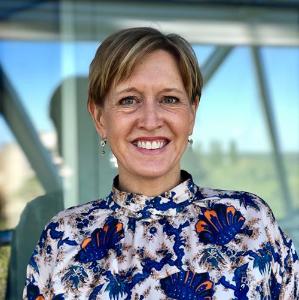« Une stratégie mondiale est à l’œuvre pour protéger les forêts, mais aussi pour produire différemment le cacao, de manière durable. »

Aminata Bamba Diaby est issue d’une famille d’agriculteurs. Ses parents cultivaient des noix de cajou dans le nord-est de la Côte d’Ivoire. « Je vais aux champs depuis que je sais marcher », dit-elle.
Après avoir obtenu un diplôme en techniques agricoles à Yamoussoukro, la capitale de la Côte d’Ivoire, Aminata Bamba Diaby a exercé en tant qu’auditrice en développement durable. Son travail consistait notamment à aider les agriculteurs à améliorer leurs connaissances et leurs pratiques agricoles. « Nous, les techniciens qui sortions de l’école, avons pu retourner dans les campagnes pour travailler avec les producteurs et les aider à améliorer leurs conditions de vie », explique-t-elle.
Depuis 2022, elle coordonne les programmes de durabilité du syndicat ECOOKIM, qui regroupe 33 coopératives agricoles (environ 45 000 agriculteurs), et d’Akagny Cacao, un exportateur de cacao. Avec son équipe, elle veille à la conformité des fèves négociées par Akagny aux certifications internationales en matière de durabilité, telles que Rainforest Alliance, et aux règles de l’UE de plus en plus strictes.
La Côte d’Ivoire est le premier producteur mondial de cacao : environ deux tiers de sa production sont exportés vers les chocolateries de l’Union européenne. Or la production de cacao est une cause majeure de déforestation et le travail des enfants y est très répandu. De 2000 à 2019, environ 2,4 millions d’hectares de forêt ont été défrichés en Côte d’Ivoire pour la culture du cacao, une zone de la taille du Rwanda.
En janvier, la Banque européenne d’investissement a annoncé un prêt intermédié de 100 millions d’euros en faveur de la Banque nationale d’investissement (BNI), le plus grand bailleur de fonds de la filière du cacao en Côte d’Ivoire. Les fonds soutiendront l’emploi des jeunes, l’égalité des sexes et le secteur du cacao. Environ un tiers des fonds ira aux producteurs certifiés et aux entreprises comme Akagny qui transforment et exportent un cacao durable.
Grâce aux prêts intermédiés, des banques telles que la BNI sont en mesure d’accorder un grand nombre de petits prêts à des entreprises dans tout le pays. La BNI a quant à elle octroyé un prêt de 3,3 millions d’euros à Akagny pour acheter du cacao certifié. Les recettes de la vente de cacao financent des projets en faveur des communautés locales : formations et équipements pour aider les agriculteurs à améliorer les rendements, soutien à des programmes qui promeuvent l’emploi des femmes et leur autonomie financière, et construction d’écoles et d’autres infrastructures telles que des châteaux d’eau. « Certaines de ces communautés n’ont pas accès à l’eau potable », explique Aminata Bamba Diaby.
Des cartographies numériques pour empêcher la culture du cacao dans les forêts protégées
De concert avec des coopératives locales, Akagny élabore une cartographie numérique des emplacements exacts des plantations afin de s’assurer qu’elles ne se trouvent pas dans des zones protégées. Une correspondance numérique est ensuite établie entre la géolocalisation des surfaces cultivées et les cartes des zones protégées fournies par les autorités ivoiriennes et des organisations internationales telles que l’Institut forestier européen et l’Observatoire mondial des forêts. Akagny collecte ce type de données depuis 2012.
« Si un agent chargé de cartographier les cultures reçoit un signal indiquant que la zone est interdite, nous cessons immédiatement notre suivi et notre soutien au producteur », explique Aminata Bamba Diaby. « Cela fait longtemps que nous nous appuyons sur ce système, car nous devons nous assurer que les cultures ne se trouvent pas dans une zone non autorisée. »
Les agents locaux collectent en outre des informations sur le bien-être des agriculteurs et de leur famille et les consignent dans une base de données centrale. Cette base contient un ensemble d’informations sur les différentes communautés, telles que le nombre d’enfants scolarisés, le nombre d’écoles disponibles et l’accès ou non à un approvisionnement en eau salubre.
Aminata Bamba Diaby précise que les données recueillies aident ECOOKIM à sélectionner les projets à financer. « Par exemple, si le taux d’abandon des études est élevé ou le taux de scolarisation faible dans une communauté, cela signifie qu’une école doit y être construite », dit-elle.

Wikimedia
Amélioration des rendements et des moyens de subsistance grâce au partage des recettes
Les recettes du cacao servent également à financer des microcrédits pour les agriculteurs, qui ont rarement accès au crédit bancaire, ainsi que des produits qui améliorent la santé des végétaux et la productivité. Dans le même temps, ECOOKIM organise des formations pour les agriculteurs sur les bonnes pratiques agricoles et les questions sociales que sont le travail des enfants, le travail forcé et les discriminations.
Le syndicat propose également aux femmes un programme d’épargne qui leur permet d’obtenir de petits prêts pour produire leurs cultures ou créer une petite entreprise, comme un magasin ou un restaurant. De fait, lorsque les femmes cultivent le cacao en famille, elles ne disposent que rarement de l’argent gagné. « Il s’agit de créer une activité génératrice de revenus pour les femmes », explique Aminata Bamba Diaby.
Le but ultime est de rendre la culture du cacao plus rentable et, par conséquent, d’améliorer les conditions de vie des agriculteurs et de leur famille. Mais Aminata Bamba Diaby redoute que les changements climatiques compromettent ces efforts. Les phénomènes météorologiques extrêmes comme les sécheresses et les inondations pèsent sur la production de cacao, tout comme le manque d’investissement dans le renouvellement des cultures. De quoi risquer d’éroder les récents gains de revenus.
« L’agriculteur doit pouvoir vivre décemment de la culture du cacao », dit-elle. « Nous n’en sommes pas encore là. Et je crains même que les changements climatiques et la diminution des récoltes n’entraînent une régression. »

